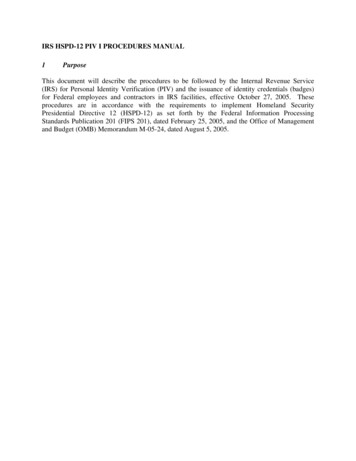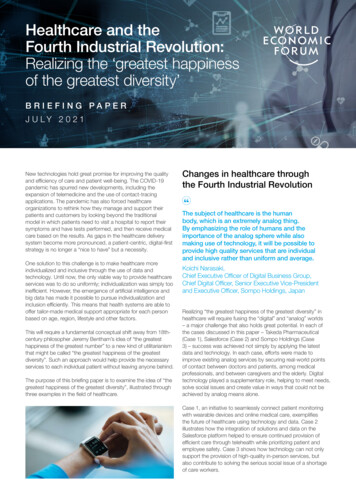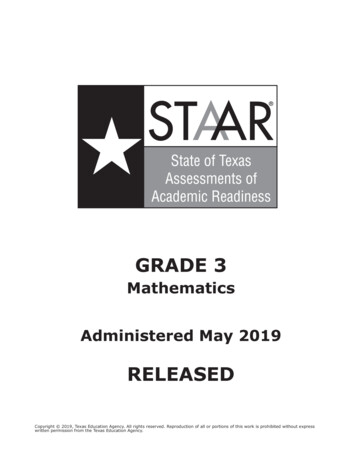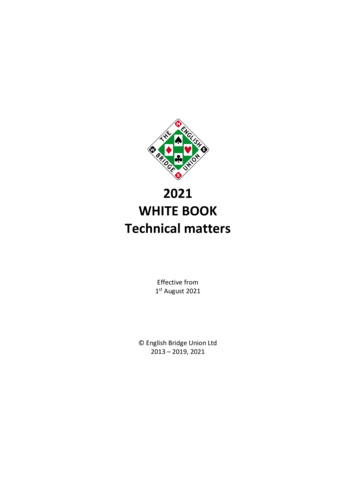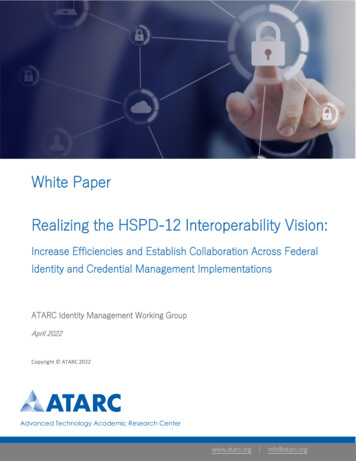
Transcription
White PaperRealizing the HSPD-12 Interoperability Vision:Increase Efficiencies and Establish Collaboration Across FederalIdentity and Credential Management ImplementationsATARC Identity Management Working GroupApril 2022Copyright ATARC 2022Advanced Technology Academic Research Centerwww.atarc.org info@atarc.org
White Paper: Realizing the HSPD-12 Interoperability VisionTable of Contents1Executive Summary . 12Background . 23Purpose . 34Identified Challenges . 4One person:Many PIV cards.4PIV card issuers as silos.4Inefficiency drives non-compliance .55Market Opportunity . 66Next Steps . 77Authoritative References . 8Guidance .8Directive & Memoranda .8Disclaimer: This Guidebook was prepared by the members of the ATARC Identity Management WorkingGroup in their personal capacity. The opinions expressed do not reflect any specific individual nor anyorganization or agency they are affiliated with.Page ii
DevOps Metrics-Performance Playbook1Executive SummaryThis paper seeks to highlight the persistent challenges present within the Federal Government about theredundant issuance and validation of Personal Identity Verification (PIV) credentials to federalemployees and contractors and provide several recommendations to address them. These challengesare: (1) multiple PIV credentials issued to one person, (2) siloed and incompatible PIV card issuance, and(3) lack of efficiency to leverage enrollment processes across federal agencies. These challenges areoften highlighted when multiple PIV cards are provided to a single person from disparateorganizations—such as, a federal employee on-detail away from their home agency or when a federalemployee or contractor simultaneously supports two or more agencies. Organizational policy decisionsand limitations to successfully implement a technical solution appear to be the driving cause of thesechallenges. The effect is an increase in costs for the federal PIV issuance systems; wasteful andredundant identity verification services; increased work for technical staff to maintain multiple chains oftrust within their identity management store; and an increased risk of compromising identity data.The Advanced Technology Academic Research Center (ATARC) Identity Management Working Group willsupport its recommendations for these challenges by seeking industry input to demonstrate potentialsolutions, with the goal of modernizing backend PIV issuance mechanisms and PIV-enabled systems.Subsequently, these technology demonstrations in the ATARC Identity Management Laboratory couldpotentially support policy revisions that improve process efficiencies in agency PIV programs and realizethe intent of HSPD-12.Page 1
DevOps Metrics-Performance Playbook2 BackgroundHomeland Security Presidential Directive 12 (HSPD-12) established the requirement for a “ mandatory,Government-wide standard for secure and reliable forms of identification issued by the FederalGovernment to its employees and contractors”1. It stipulates how the identity credentials are to beused, with interoperability in both physical and logical access. In response to this directive, the NationalInstitute of Standards and Technology (NIST) released the Federal Information Processing Standard(FIPS) 201, Personal Identity Verification (PIV) of Federal Employees and Contractors. One of the goals ofFIPS 201 was to describe specifications to support technical interoperability of the PIV credentialsamong Federal agencies and departments2. Since the release of FIPS 201, agencies have responded byimplementing internal policies and practices resulting in parallel enrollment processes, physical accesssolutions that do not meet the interoperable intent, plus an increase in the overall cost of maintainingthe PIV infrastructure along with the logistical challenge of maintaining multiple cards. Further, thereare more than 10 hosted PIV enrollment services with redundant enrollment data (e.g., fingerprints,photos, and personal identifiable information). These PIV enrollment services maintain little to nocommunication between their respective databases to help improve inter-organizational trust and PIVcard interoperability. The Office of Management and Budget (OMB) is aware of these challenges and hassince then issued memoranda OMB M-11-11, OMB M-19-17, and OMB M-22-09 with the aim ofclarifying the requirements. OMB M-19-17 states “Agency processes shall accept and electronicallyverify PIV credentials issued by other agencies. This is equally applicable for local and physical accesswhere another agency’s employee has been provisioned access”3. Despite these memoranda, the vastmajority of federal agencies continue to deploy systems with no ability to accept other agencies’ PIVcredentials. According to the USAccess Program, that accounts for slightly less than half of all PIV cardsin circulation, there are at present 3,362 PIV card holders that have two (2) or more valid PIV credentialswith two (2) or more agencies. The duplication of PIV cards stems from various scenarios. For example,some contractors or federal employees support multiple agencies. The lack of credential interoperabilityor reuse to support these agencies, results in customary practices to issue them a different PIVcredential from each agency supported. If the federal employee or contractor is working a long-termassignment at another agency, their multiple PIV credentials (PIV/PIV-I) will be concurrently valid.A second scenario is a federal employee who takes a new job at a different agency. This creates thesituation of undergoing another enrollment process to obtain a new PIV card while having a valid one—often with months or years of validity still left on the valid card. Yet, that credential will be revoked as anew PIV card is issued representing the affiliation with the new agency. Is organizational affiliationworth the reissuance of an identity credential when a federal employee or contractor possesses acurrent and valid PIV card? The number of PIV credentials that are revoked “early” for this reason ismany orders of magnitude greater than agencies’ efforts to make credentials /2019/05/M-19-17.pdf2Page 2
DevOps Metrics-Performance Playbook3 PurposeThis paper seeks to: (1) describe the challenges occurring with the Federal Government’simplementation of HSPD-12, and the growing operational cost incurred by agencies not complying withpolicy and standards, and (2) provide recommendations that will result in internal governmentefficiencies and effectiveness for identity management enrollment and provisioning practices.In response to these identified challenges, the ATARC Identity Management Working Group will look toshowcase solutions in the ATARC Identity Management lab that will demonstrate the feasibility foragencies to leverage one PIV card per person across the entirety of the federal landscape.Page 3
DevOps Metrics-Performance Playbook4 Identified ChallengesOne person:Many PIV cardsIn the majority of cases, agencies currently issue an agency or department affiliated PIV or PIV-I card toany external federal employee or contractor, independent of whether that individual is a current andvalid PIV cardholder from another agency. While the reasons for this are many, the most common isinsufficient infrastructure to support physical and logical validation of the PIV card electronically againstall PIV card issuers. This lack of cross-agency interoperability is in direct contrast to the objectivesidentified in HSPD-12, whereas the resulting PIV card was to be a “Secure and Reliable forms ofidentification” and “can be rapidly authenticated electronically.” By not being able to reliably validate anexisting PIV card, or in many cases check for whether an individual is a current, valid PIV cardholder,agencies are forced to require issuance of their own affiliated PIV card which can work with theirexisting infrastructure.PIV card issuers as silosAs directed through HSPD-12, NIST was asked to create an interoperable and trustworthy enrollmentrecord format that could be reused and transferred between PIV issuers. Through this direction, NISThas seen three revisions of the FIPS 201 framework released. Despite this framework, issuers today actin isolation without sharing information between issuance systems and corresponding backenddatabases. To date, no PIV card issuer has implemented a solution consistent with this guidance andshared an enrollment package with any other PIV card issuers. As an extension of its FIPS 201 guidance,NIST created SP 800-1564 with its introductory purpose stating the following:The chain-of-trust offers process efficiencies because a PIV Card can be re-issued basedon the most current chain-of-trust record, and more importantly, can avoid having torepeat the identity proofing and re-registration (re-enrollment) process. Departmentsand agencies that implement a chain-of-trust will also be able to transfer the record toanother agency or to a service provider, so that the receiving agency or service providercan use the record to issue a PIV Card rather than re-enroll an applicant. This SpecialPublication provides the representation of a chain-of-trust for import and exportbetween PIV Card issuers.As defined through these NIST publications, a critical component of the enrollment package isbackground verification status and final investigative status. By failing to adopt a compliant chain-oftrust enrollment record, an element identified specifically within the 800-156 NIST special publication,agencies have incurred higher than necessary costs for the issuance and lifecycle management of theirPIV cardholder population. These costs are typically incurred through the lost time and material costassociated with requiring current and valid PIV cardholders to physically report to a PIV issuance stationto receive an additional PIV card. Arguably, the largest source of cost is the incremental backgroundcheck. Having an ability to let a current valid background check stand, and be available for validation, cations/NIST.SP.800-156.pdfPage 4
DevOps Metrics-Performance Playbookany agency with need of this information would improve interoperability, and lead to a significantreduction in the costs.Inefficiency drives non-complianceMany agencies have been slow to implement FICAM compliant and interoperable systems. As such, theFIPS 201 goal of implementing a “one person:one PIV card” paradigm has not yet been achieved due tobudget, logistical, technical, and administrative constraints that are unique to each agency. The impactfrom these constraints is an agency’s increase in cost and time to manage the identity of a single personusing multiple PIV cards rather than establishing both technical and process interoperability using acentralized chain-of-trust. Further, these constraints drive inefficiencies and non-compliance that arereflected in how federal employees and contractors gain physical and logical access to federal facilitiesand systems. For example, the use of Physical Access Control Systems (PACS) to access federal facilitieswere not PKI-based before the initial release of FIPS 201. Visual inspection, non-cryptographicauthentication modes, and continued reliance on less secure proximity-based RFID (radio frequencyidentification) technology has persisted at various posts throughout the last decade and a half instead,despite the advancements in compliant PIV-based PACS validated entry control points.In addition to the challenges prevalent within interagency PACS validation, Logical Access ControlSystems (LACS) have seen similar inefficiency challenges. These specific LACS interoperability issues arenot in scope within this document, but their existence shares equal rooting to the same challengesdriving multiple PIV card issuance and should therefore be acknowledged. These challenges areespecially important in consideration of the current Administration’s goals and policies driving towardszero trust architecture. The ATARC Identity Management Working Group will address these PIV LACSinteroperability challenges in a future publication.Page 5
DevOps Metrics-Performance Playbook5 Market OpportunityThere is a need to reduce the number of times an individual’s Personally Identifiable Information (PII) iscaptured so only a single PIV record is created. Also, there is a need to increase interoperable trust of asingle PIV record for government-wide use.Federal departments and agencies present an opportunity to reduce operating and personnel costs, aswell as a potential reduction in the exposure of PII data. All PIV card issuers should be mandated toleverage NIST SP-800-156 complaint Credential Management Systems (CMS). While OMB and NIST havedefined and mandated an interoperable PIV issuance infrastructure, such infrastructure does not existtoday, and many technical barriers exist preventing easy cross-agency validation and determination ofan individual’s PIV cardholder status across the Federal Government. Therefore, we recommend aprocess should be established at the Federal Public Key Infrastructure Policy Authority (FPKIPA) tofacilitate secure requests for enrollment records among issuers. Such an establishment should combatsiloed PIV issuance and allow agencies and departments the ability to validate and trust the issued PIVcredentials from other PIV issuance providers.Industry has also seen value in reducing silos created through proprietary issuance systems. Work hasbeen done to examine each interface involved in the entire PIV issuance process. There are two effortsunderway which COTS (commercial-off-the-shelf) technology manufacturers are following and beginningto implement:The OSIA framework (https://secureidentityalliance.org/osia-about)The MOSIP API (https://www.mosip.io/)As of the writing of this paper, there is effort to converge these two efforts. This should allow for evengreater flexibility of intermingling the various components of identity enrollment and credentialissuance. We recommend advancing these efforts to enable one enrollment station with any othercredential management system. NIST SP 800-156 provides data interoperability among entire credentialenrollment systems. These efforts are providing interoperability among the technical components thathandle the data.This opportunity to update and modernize the backend PIV framework, to break down the existingissuance silos, reduce, and ultimately, eliminate the number of individuals carrying multiple PIV cards,will see greater recognition of the original vision of HSPD-12.Page 6
DevOps Metrics-Performance Playbook6 Next StepsThe ATARC Identity Management Working Group is providing this white paper for a 60-day commentperiod, seeking feedback from government and industry stakeholders. We will leverage this feedback, inaddition to the recommendations noted, to demonstrate the ability to implement this proposedmodernization approach through outreach to industry, and establishment of the ATARC IdentityManagement Laboratory. The lab will provide practical demonstration of government or commercial offthe-shelf (GOTS/COTS) solutions to facilitate agency compliance with FIPS 201.Page 7
DevOps Metrics-Performance Playbook7 Authoritative ReferencesGuidanceTitleDescriptionFIPS 201-3This is the standard for federal agencies to implement HSPD-12.800-156This is a special publication on how federal agencies can establish a chain-of-trustrecord to facilitate the exchange of PIV card enrollment data.Directive & MemorandaTitleDescriptionHSPD-12This is a directive that directs federal agencies to implement standardized badgingto include security principles.OMB M-11-11This memorandum affirms the importance to implement HSPD-12 within federalagencies and clarifies requirements.OMB M-19-17This memorandum re-affirms HSPD-12 as the way to implement standardizedbadging and encourages federal agencies to leverage PIV credentials with otherauthentication form factors.OMB M-22-09This memorandum lays out the strategy for federal agencies to improve onenterprise identity and access controls.Page 8
FIPS 201 goal of implementing a "one person:one PIV card" paradigm has not yet been achieved due to budget, logistical, technical, and administrative constraints that are unique to each agency. The impact from these constraints is an agency's increase in cost and time to manage the identity of a single person


